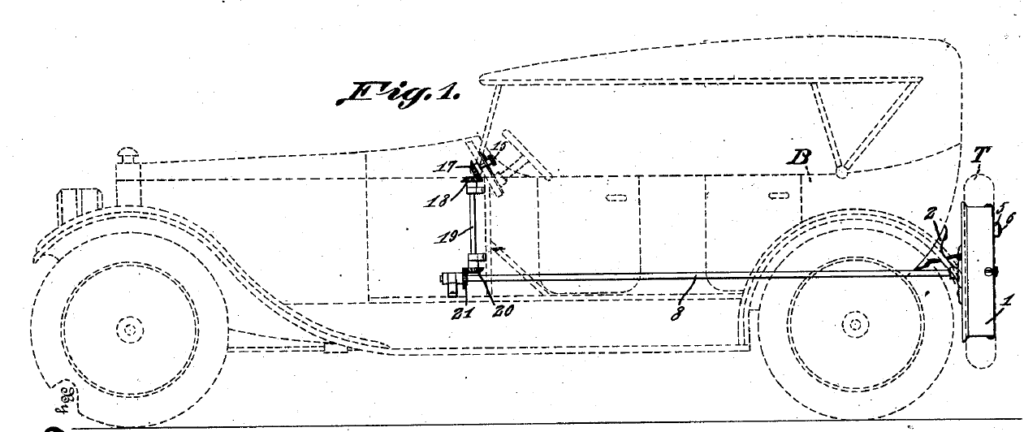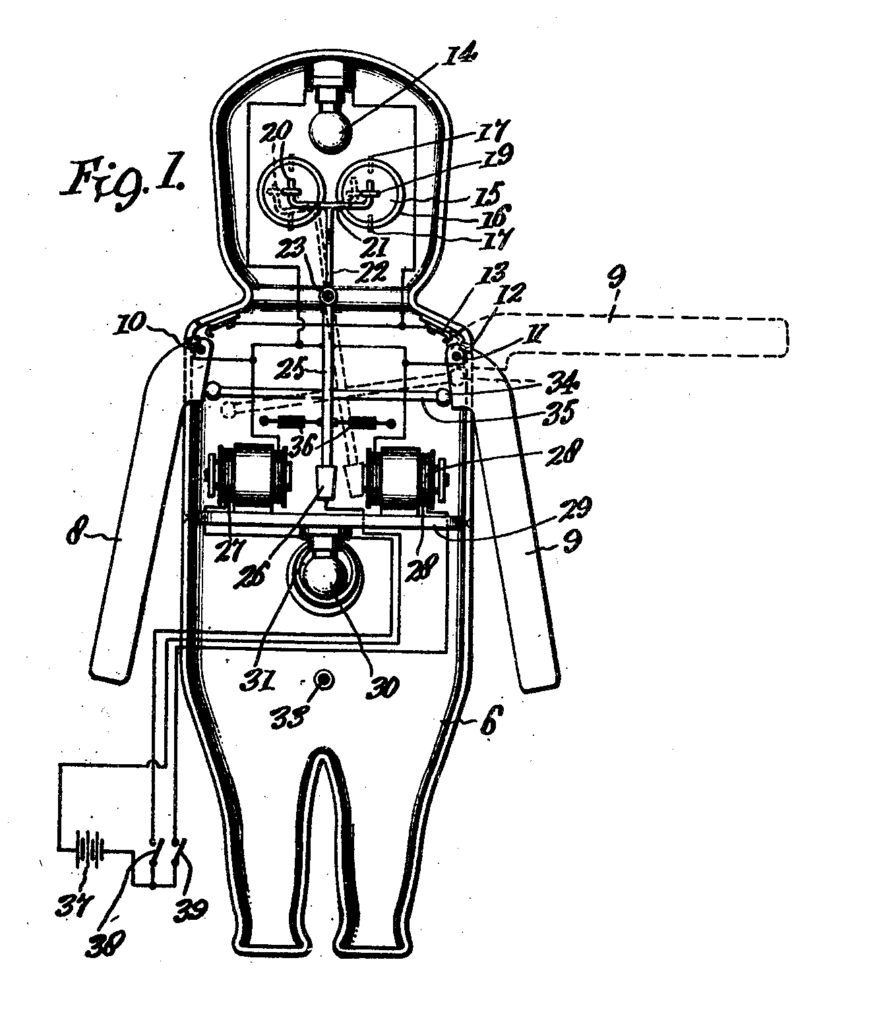On August 10, 1982, George W. Lucas, Jr. Ralph McQuarrie, Joseph E. Johnston, and Stuart Freeborn, received U.S. Patent No. D265754 on a toy Figure (Yoda!):
Monthly Archives: August 2024
August 9, 2024
On August 9, 1898, U,S, Patent No. 608,845 issued to Rudolf Diesel on an Internal Combustion Engine (the “Diesel Engine”):
Diesel engines are more efficient than, and thus an important replacement for, steam engines or gasoline engines. Unfortunately, Diesel was not able to enjoy the success of his invention. He disappeared on the evening of 29 September 1913, Diesel disappeared from the SS Dresden as it sailed from Antwerp to London.
August 8, 2024
On August 8, 1911, U.S. Patent No. 1,000,000,issued to Francis Holton for a vehicle tire

As of August 8, 2024, we are at U.S. Patent No. 12,058,943. In 113 years approximately 11,058,943 utility patents have issued averaging 97867 per year for 113 years or 8756 per month for 1356 months or 268 patents per day for 41, 274 days. That’s a lot of inventing!
August 7, 2024
On August 7, 1990, Donald Bonasia received U.S. Patent No. D309695 on the Chop Stick Fork.
A little more than a year later on October 15, 1991, Frank J. Brincat received U.S. Patent No. 5,056,173 on a Combination Fork and Chopsticks.

Brincat’s utensil seems to be a significant improvement over Bonasia’s utensil. Combination eating utensils have been an active field of endeavor.
U.S. Patent No. 147,119, from February 3, 1874, on combined Knives, Forks, and Spoons, is perhaps the earliest example:
U.S. Patent No. D190198 from April 25, 1961, shows a more recent adaptation:
U.S. Patent No. 4,771,541 from September 20, 1988, discloses a combination fork and knife:
U.S. Patent No. 4,984,367 from January 15, 1991, discloses a combination utensil:
U.S. Patent No. D388,664, issued January 6, 1998, is the first patent literally on a “Spork”:
Other “Spork” patents include: D633344, D657625, D722836, D723341, D736039, D771,444, D778,120, D822,443, D858,214, D876907, D909,821, D910386, D979,350, and D1026571.
August 6, 2024
On August 6, 1935, William D. Coolidge received U.S. Patent No. 2,010,712 on an improved cathode ray tube. Cathode ray tubes were critical to televisions and computer monitors until the relatively recent invention of LCD screens, and they are still used to generate x-rays in medical imaging equipment.
In 1911 Coolidge developed a ductile form of tungsten that made the manufacture of filaments for incandescent bulbs, for which in received U.S. Patent No. 1,082,933 (later declared invalid. IN 1913 Coolidge invented a hot cathode tube dubbed the Cooliidge tube that allowed for improved medical imaging, for which he received U.S. Patent No, 1,203,495. His basic design is still in use today.
Coolidge won The American Academy of Arts and Sciences Rumford Prize in 1914; was elected to the United States National Academy of Sciences in 1925; the Howard N. Potts Medal in 1926; the Louis E. Levy Medal in 1927; was elected to the American Philosophical Society in 1938; was awarded the Faraday Medal in 1939; was awarded the Franklin Medal in 1944. In 1975, shortly before his death at age 101, he was elected to the National Inventors Hall of Fame.
August 4, 2024
On August 4, 1925, U.S. Patent No. 1,548,653 issued to Martin Borglum on an Automobile Signal. 99 years later it is hard to image the problems still to be solved in the automobile industry, and the limited technological resources to address those problems. Mr. Borglum’s solution to signaling direction changes? Hang a “peculiar and grotesque figure adapted to be mounted upon the vehicle in a conspicuous position in which the figure will have movable arms for indicating visually proposed changes in direction of the vehicle and movable eyeballs coordinated with the arms to shift in the same direction with the latter whereby to vary forcibly and in an odd striking way call attention to the signal and to the proposed change in direction” on the side of the car:
That this seemed like a good idea in 1925 is a testament to how far we have progressed since then. Here’s a better view of Mr. Borglum’s Cargoyle:
Directional signaling was apparently one of the big problems of the day, because that same day several other patents issued on direction signals. Anthony Ritsky proposed mounting a spinning arrow on the car fender in his U.S. Patent No. 1,548,386:
George L.Cantwell proposed a signal mounted on the spare tire on the back of the car with an arrow that signals the driver’s intent in his U.S. Patent No. 1,548,115:

Three entirely different solutions to one of the problems of the day, brilliantly illustrating the importance of diversity in thought. There are few bad ideas — just different levels of good ideas.
August 3, 2024
On August 3, 1840, U.S. Patent No, 1711 issued to William Howe on a Truss Bridge.
This design was an improvement over his previous design, patented a month earlier on July 10, 1840, as U.S. Patent No. 1685:
Howe’s design was widely used through the middle and end of the 19th century, and was often used in the construction of covered bridges because the cover would protect the timbers in the truss, extending the life of the bridge. Howe patented (U.S. Patent No. 4726) a further improvement in 1846.
The Howe’s were a particular inventive family, with several members making inventions and getting, patents, the most notable is William’s nephew Elias, knows as the inventor of the sewing machine. Elias’ U.S. Patent No. 4750 was not the first patent on a sewing machine, but its lockstitch method was a substantial improvement. Meeting with limited commercial success, however, Elias turned to enforcement, and after many years of litigation, in 1856 formed the first American patent pool with Wheeler &Wilson, Grover & Baker, and another familiar name in sewing machines, I.M. Singer.
August 2, 2024
On August 2, 1892, George A. Wheeler received U.S. Patent No. 479,864, titled “Elevator,” but which was really the first patent issued on what we now call an escalator.
Jesse Reno received a patent (U.S. Patent No. 470918) on an endless conveyor or elevator about a year earlier on an endless conveyor or elevator, but it was more of a conveyor belt, as the title implies, than what we call an escalator. Reno’s device was actually installed in Coney Island for a brief time, where it lifted park patrons to the dizzying height of 7 feet. In 1902, Reno founded the Reno Electric Stairways and Conveyors, Ltd. and installed his invention in various locations. Otis eventually purchased Reno’s patents when Otis entered the field a few years later.
Another important name in the development of the modern escalator is Charles D. Seeberger. Working with Otis he installed the first step-type escalator made for public use at the Paris Exhibition of 1900 (where it won first prize). He applied for a patent on October 7, 1901, which bumped around the Patent Office for nearly a decade before issuing as U.S. Patent No. 994,879:

Seeberger received numerous patents on escalators, including U.S. Patent No. 999,885, 1,014,400. 1,014,856, 1,015,406, 1,020,060, 1,023,443, 1,025,316, 1,034,841. 1,043,542, 1,049,613, and 1,095,361.
Patents aside, Seeberger really is the inventor of the escalator. He coined the term from scala (Latin for steps) with elevator. He registered the term as his trademark on (Reg. No. 84,724) on May 29, 1900, which he eventually assigned to Otis. However, in 1950 in Haughton Elevator Company v. Seeberger, the registration on ESCALATOR was cancelled because the term had become generic. The decision noted the that escalator was used by Otis the same way as it used the generic term elevator, the Commissioner noting that “the word ‘escalator’ or “escalators’ is written in small letters and in the same manner and same context as the word ‘elevator’ or ‘elevators’ which obviously has not trade mark significance.” 85 U.S.P.Q. 80, 81 (Comm’r 1950). It is a common problem with inventors of something new, that the name they give their new product often becomes the generic name for that new product, particular if the the term is used carelessly.
August 1, 2024
On August 1, 1893, Henry D. Perky and William H. Ford were issued U.S. Patent No. 502378 on a Machines for the Preparation of Cereals for Food, which forms the boiled, steamed, steeped, or soaked grain into the familiar “pillow” shape of shredded wheat. He introduced the product at the Chicago World’s Fair in 1893.
In 1895 Perky was issued U.S. Patent No. 548,086, as well as U.S. Patent No. D24688 on the shape of the biscuit itself:

After the patents expired, Kellogg Company saw that as an opportunity for Kellogg’s to sell its own version of the product. Kellogg obtained a patent on the biscuit in 1916, and Kellogg’s Shredded Wheat was born. Kellogg obtained its own patents on the shredded wheat biscuit (U.S. Patent No. 1,168,888), numerous patents on the method of prepare shredded wheat biscuits (U.S. Patent Nos. 1,102,614, 1,124,363, 1,159,045, 1,170,162, and 1,197,297), on the package for the shredded wheat biscuits (U.S. Patent No. 1,914,336), and entered the market.
This provoked Perky’s successor National Biscuit Company to sue Kellogg for trademark infringement, attempting to enjoin it from using Shredded Wheat as a trademark and from manufacturing the cereal in its pillow-shaped form. The case eventually made it to the United States Supreme Court case Kellogg Co. v. National Biscuit Co., 305 U.S. 111, 59 S.Ct. 109, 83 L.Ed. 73 (1938). The Supreme Court held that the term “shredded wheat” was generic and not trademarkable — it was a term in public use for the product, and was how the product was described in the expired patents. Further, the court held that when the patent for the shredded wheat machinery expired in 1912, the right to make the shredded wheat “pillows” and apply the name “shredded wheat” to the resulting product, passed into the public domain along with that patent. This has been an important limitation of trade dress rights ever since.
A side lesson to learn is that St. Louis (the ice cream cone) handily beats Chicago (shredded wheat) as far as World’s Fair Food is concerned.
















